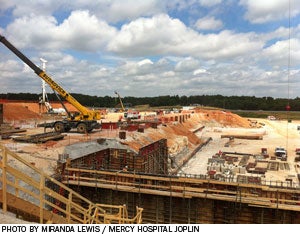Mercy Hospital design maximizes patient safety
 |
| Mercy's new permanent hospital in Joplin is being built to withstand severe weather. |
After an EF5 tornado destroyed St. John's Regional Medical Center in Joplin, Mo., on May 22, 2011, Mercy health system is not taking any chances with the new permanent hospital now under construction. The designers and builders of Mercy Hospital Joplin, due for a March 2015 opening, are taking considerable design precautions to minimize the risk of fatalities and damage to the facility if the unthinkable occurs again.
John Farnen, executive director of strategic projects for planning, design and construction, Mercy, St. Louis, says the new $500 million, 900,000-square-foot facility will include several changes that will harden the facility against any severe weather the area may encounter. The 2011 tornado and storm largely destroyed St. John's and leveled much of Joplin. "It's good engineering and lessons learned from what happened to St. John's," Farnen says about the new hospital's design plan.
Because many of the windows in St. John's shattered in the storm, sending glass flying around the inside of the facility, all windows in exterior walls at Mercy Hospital will be laminated, says Farnen. Hurricane-rated windows will be installed in critical areas such as the intensive care unit (ICU) pediatric ICU, neonatal ICU and the emergency department, he says. Interior safe zones protected by heavy storm doors and internal walls will be created as added protection for patients and staff.
The entire roof will be made of concrete. Sections of St. John's roof were made of metal decking with insulation and a roof membrane held down by rocks, which became airborne during the storm, says Farnen. The hospital's exterior skin will be built with brick and concrete rather than Styrofoam and plaster as in some office areas at St. John's.
Steps are being taken to make sure the central utility plant and all fuel and power sources are well protected in the event of a storm or catastrophe. Part of the central plant will be underground and the part above ground will be made of reinforced concrete and brick.
Diesel fuel tanks will be buried underground and hold enough fuel to keep boilers and generators operating for 96 hours instead of the minimum 24 hours, Farnen says. The power generators will be installed inside a hardened structure rather than outside the hospital as at St. John's. Local utility Empire District Electric Co. will build a new substation near the hospital, which gives it two power sources in an emergency, making the generators a third power source.
Two of the hospital's nine floors will be completely underground. One floor will house utilities and the second will house operating rooms and ED functions.
The planned structural changes and improvements to maximize the safety of the hospital added about $12 million to the overall cost. Considering what happened that horrific day in May 2011, Mercy leaders call it a wise investment, Farnen says.




